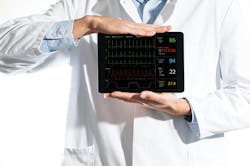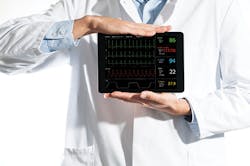Strict EMC rules aim for secure healthcare environment
Prevention is better than cure, and the fourth edition of IEC 60601-1-2 certainly takes that to heart. The updated standard introduces many technical changes for electromagnetic compatibility (EMC) requirements for medical devices with an eye toward ensuring that EMC phenomena do not interrupt or jeopardize safe healthcare delivery in today’s technologically complex environment.
The new standard comes into force in April 2017 in the United States and Canada, and it has been reported that the U.S. Food and Drug Administration (FDA) already not only accepts the fourth edition but asks for it on new 510(k) applications. The compliance date for the European Union has not yet been announced but is expected shortly; some in the industry speculate it may be August 2017. This article explains the fourth edition’s technical changes and how they will affect the testing and certification process.
A new EMC paradigm
Medical device manufacturers will notice that the fourth edition’s technical changes stem from the new EMC paradigm. Tests and limits are set according to risk and intended use, not according to a device type. The environment of intended use must be specified in the test report and can include a healthcare facility, home, and a special environment such as military, heavy industrial, or medical treatment area with high-powered medical equipment. The home environment comprises almost everything except the healthcare facility, such as restaurants, shops, schools, churches, libraries, vehicles, train and bus stations, airports, hotels, and museums. Medical devices will be tested based on their intended use, and equipment designed for special environments may need to be tested for immunity at levels higher or lower than the levels specified for the healthcare and home environments.
A closer look at EMC risks
Section 4.1 and Annex F of the fourth edition require that manufacturers include EMC risks in the risk management file, which the test laboratory now needs to review. The laboratory’s responsibility is to ensure the device maker adequately addressed all EMC risks without actually evaluating the file.
While the fourth-edition requirements cover the usual EMC phenomena, manufacturers are encouraged to consider other EMC risks specific to the environment of use in their risk analysis. That means the product may need to be tested to other EMC standards, such as IEC 61000-4-16 and MIL-STD 461.
Additionally, section 6.2 of the standard instructs the manufacturer to provide an EMC test plan to the laboratory. Table G1 of section 6.2 explains what to include in it. As with the risk-management file, the EMC lab does not evaluate the test plan but must follow it to the letter. Manufacturers can refer to Annex G for guidance on writing a test plan, which needs to be included in the test report.
In addition to the test plan and risk-management file, manufacturers must supply the test lab with a more in-depth description of the device’s essential performance; specify detailed, product-specific performance criteria for use during the immunity testing; write a specific plan allowing for monitoring the performance of the device during immunity testing; and supply a copy of the instructions for use and accompanying documents for review (per Section 5).
A checklist of technical changes
The normative references to the basic standards were updated, triggering some technical changes on top of the standard’s actual modifications. Here is a checklist of updates.
- Connector pins need to be tested for ESD if they are accessible by the standard test finger.
- Immunity testing of DC inputs now is required, and 12-VDC inputs must be surge tested.
- The test levels for magnetic field immunity on medical products are increased to 30 A/m.
- Voltage dips and variations now are synchronized at 45-degree increments of the AC line.
- Fast transient immunity tests must be performed at a 100-kHz repetition rate instead of a 5-kHz rate.
- Conducted immunity levels are increased from 3 Vrms to 6 Vrms in the ISM frequency bands.
- Radiated immunity is specified to 2.7 GHz instead of 2.5 GHz, and modulation now is 1 kHz, in line with requirements in similar EMC standards.
- ESD immunity levels are increased significantly to 8-kV contact to metal surfaces and 15-kV air discharge to plastic nonconductive surfaces.
- A new wireless coexistence test increases the radiated immunity test levels to 28 V/m at spot frequencies from 385 MHz to 5.8 GHz per Table 9. These levels are increased to assess the product’s susceptibility to interference from common wireless devices used within 30 cm. The wireless proximity test is more severe than the old FDA wireless coexistence test.
- AC line immunity tests are performed at only one line voltage instead of two voltages specified in the third edition.
- A new requirement considers patient-connected tubes filled with conductive liquid as cables and instructs they be tested for conducted immunity. Manufacturers can refer to Table 7 for specifications. Medical device manufacturers should take note that the FDA does not accept the immunity testing exclusion for signal cables less than 3 meters long and requires cables be tested.
- Wireless communication devices must have the wireless function on during the immunity testing.
- The fourth edition includes a new Table 1 showing at what line voltage immunity tests must be performed.
Information technology in medical equipment
According to section 4.2 of the fourth edition, information technology equipment (ITE) that does not affect the basic safety or essential performance of the medical system can be evaluated to the ITE standards EN 55022, EN 55032, and EN 55024, which require testing above 1 GHz.
If ITE affects the basic safety and essential performance of the system, then it must be tested to IEC 60601-1-2, which references CISPR 11 edition 5.1, and likely will not need to be tested above 1 GHz (unless the system was classified as Group 2). Some equipment categories, such as Group 2 and devices operating above 400 MHz, require testing above 1 GHz for emissions.
Testing for immunity below standard levels
Manufacturers will likely find it more challenging now to specify immunity levels lower than standard levels in their test plans and justify them via risk management. Annex E in IEC 60601-1-2 describes how to justify immunity test levels deviating from the standard. The explanation will need to consider the environment of use. For example, equipment designed specifically for use in a humidity-controlled environment may be allowed to meet lower ESD immunity levels.
Is it going to cost more?
The fourth edition will require some additional testing, thereby adding costs. If manufacturers provide the lab with the test plan based on their risk analysis during the quoting stage, the lab can respond with the most accurate estimates. In instances where the product was recently tested to the third edition, the manufacturer may be able to limit its testing to the differences per the fourth edition. Naturally, some products may still need to be completely retested if their risk analysis includes additional EMC risks.
Next steps
Manufacturers are advised to evaluate their designs now for future compliance, particularly if they have several products that will all need to be retested at some point. In some instances, testing to additional EMC standards may be required because of the need to consider all possible EMC risks in the risk analysis. Advance planning will help make the compliance process—and any design alterations, if necessary—less stressful and less likely to cause delays in getting products to market. EE
About the author
Bruce Fagley is the EMC technical and operations manager, EMC East, at TÜV Rheinland, responsible for technical matters of the company’s five North American EMC facilities and operations of three EMC laboratories in the East. Fagley began his EMC career 30 years ago as an international compliance engineer, and his employment at TÜV Rheinland spans 20 years. He is the author of several articles on EMC matters and the EMC notified body representative for TÜV Rheinland of North America. [email protected]


